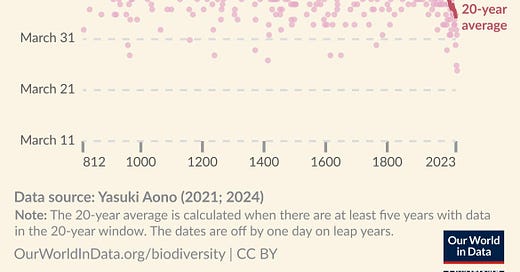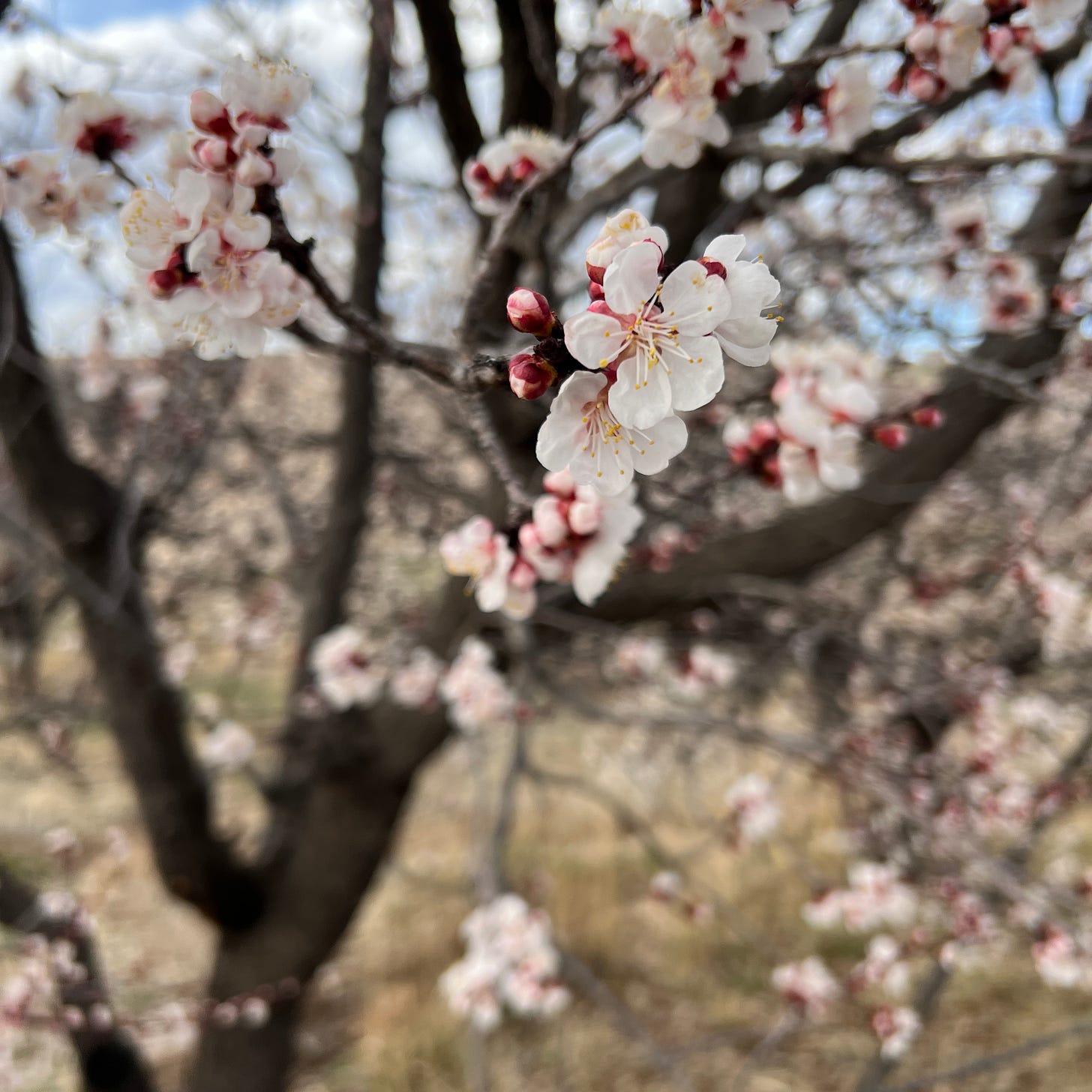Good day!
I’m currently at my friend Gini’s Garden of the Goddess outside of Santa Fe, watching a red-headed woodpecker cock its little head, listening for bugs. Out my window the Russian elm trees are starting to bud out, and the pinion tree in the distance is a hub for the many little birds twinkling by.
Here in the north spring has moved from shy peeking to serious playing. I’m waving to those of you south of the equator, who reminded me that you are feeling the hand of autumn as I write about spring. That is one of our global contradictions: that as the earth tips and moves around the sun, the top half and bottom half experience opposite seasons.
I have two other pieces written about my journey with stewardship and trees in New Mexico cued up for you; and today I’m sharing an article I helped write this week on cherry blossoms. This is such an amazing collaboration!!!! My dear friend Matthew Stillman, who was once my neighbor in NYC, and I have a weekly book club, Thursday mornings. You may remember me mentioning him in a previous article; he recently found out he has a brain tumor, and is now living in that liminal wobbly post-surgery, brain cancer mystery space, along with having epic long-Covid. I’ve been helping him write newsletters for his business, Primal Derma since he HATES writing (and um, his brain is a little compromised right now #braincancer). But here is the thing; he is a brilliant researcher and writer. So we ran an experiment this week: to see if we could co-write an article.
On Tuesday Matthew shared his idea for the article over the phone and I took notes. Then I typed up a rough draft and sent it to him. By the end of the day he had sent me revisions, and we had a final draft! Here is: Cherry blossoms and the sweep of time. Let us know what you think. : )
Clocks, the old ones, the ones that used to be in the living room of your grandparents or wound up and set upon the mantle or hung over the chalkboard at the front of class or sundialed at the edge of your uncle’s farm shows the literal movement of our understanding of time. These clocks, they have hands and faces - like us, we can see ourselves in them somehow - and a sound, seconds ticking by viscerally.
When you look at a clock suddenly the past and the future, the circle of what came before and what is yet to come is all there.
Now most clocks are abstractions: digital numbers that only show the present. 12:43 transforms into 12:44, and the past is gone. There is no future. Digital numbers freeze time and overextend the moment. The rest of the time needs to be contrived, imagined or summoned. But that time you see on your phone doesn’t blink or flutter. There is no question. No figuring of which numerals the short hand is between. And when your phone “sleeps” just “waking” the device shows you the unblinking white numeraled time.
On our phones, our wrists, and our computers time is a static reflection. The three-dimensionality, the movement, and the tick of a clock is wiped clean, neat and tidy, into a two dimensional shiny and smooth surface where the font is the same on your phone and mine. iPhones are all synced with each other. You may run late but the time on your clock is unflinching. There is a uniformity to it. And a ubiquity to it. I think it is rare to have the human moment of asking someone what the time is anymore. And of course it is a funny irony that modern clocks were virtually invented by Benedictine monks trying to figure out how to organize their days for the sake of prayer.
This is not to say we should be rid of clocks, or computers or that old clocks were better somehow. But to be aware that time is not shiny but tactile, changing, and maybe a kind of living god that is part of a larger flow and isn’t just the regulator of our sleep or our schedules..
Are we being trained by our current digital clocks to not be in connection to a larger flow?
So much around us is shiny and smooth and neutral: our kitchen appliances are shiny. Our cars are smooth, and more and more cars are white, black, or gray in the last 25 years. Your computer is probably a sleek machined aluminum and glass or a black cased box and glass. Red cars won’t save us. This isn’t redemption talk. This uniformity doesn't engage or surprise the senses the way the natural world does, or the movement of clock or even an hourglass dripping sand with its barest slow whooshing tink of the sound of tiny stone on stone.
For the past 1,200 years the Japanese have had at least one way of tracking time - through cherry blossoms. 1,200 years! This marking of the full opening of the cherry blossom marks not only of spring but as a tactile experience of beauty, time passing, fleetingness, and continuity. This kind of living and shuddering calendar is marked graphically in this chart below. And there you can see that the last 25 years the cherry blossoms have bloomed earlier and earlier than in the last 1,200 years and that is due to climate change which is a real and undoing thing. But this isn’t a climate change story alone. This is one expression of the long memory that a culture that belongs to a place might express. Time being marked by the face of beauty showing and receding.
In witnessing the blossom of the cherry flower as a marker of time moving all the senses are engaged: the sight of the delicate pink, the smell of soft spring fragrance, the sounds of birds arriving in the warming weather, the touch of petals against our face. In being part of nature's expression we are engaged in the living world, feeling the change.
When we engage with a living world around us, not as an udder to be milked and to top us off or fill us up, but as a living breathing expression of time passing, we might make or even remember our place, our little place in it all and feed that which has fed us.
Witness that arboreal flow: bare branches to buds, buds to flowers, flowers to petals blooming, petals blooming to petals scattered on dirt and sidewalks, wind blowing the light pink dust clear as green emerges fully in the trees. There is a before, a during and an after and a still. The long moment of the cherry blossom is fleeting, but also a connected birthing and dying, from bud to fruit.
May we keep turning to the living world to taste, smell, and see, and experience time as a connected flow.
Matt and Ash
How do you mark time through the seasons? Share in the comments!
And a quick love note about Matthew’s Primal Derma: I use it every day to protect, soothe, and heal my skin. It is a tallow-based, all-natural product that is like a Swiss Army Knife of skincare. And here is the cool thing: Sometimes Primal Derma is more yellow, sometimes more white, depending on what the cows are eating. It could be alfalfa, or older grasses later in the season. Who knows? But there was once a time when the taste of milk shifted throughout the year as well. This was also a kind of calendar, when we could taste the fields or flowers of specific places before it was homogenized.
Learn more about Prima Derma here: https://primalderma.com







Good morning. Your collaborative article touched all my senses. I thoroughly enjoyed each and every word, expressed with love and gratitude. Thank you for sharing such a profound history of experiences and capturing humanity in the shadows of blossoms and time. :)
In the yard of the home where I spent most of my childhood from age 2 yrs til 16 years, there were many different flowers & a couple of fruit trees. The blooming of those flowers & trees marked the changing seasons for me. The Iris & Tulip bulbs were the first to bloom in early Spring, along with the plum & green apple trees. To mark Fall, the spider lilies (my favorites) put on quite show. I can't remember about the roses & Camelia bushes. I believe they started in the spring & bloomed all summer along with the fragrant honeysuckle vines. We also had pecan trees that started leafing out when winter was positively over. What a treat, to bring these memories up. Thank you!